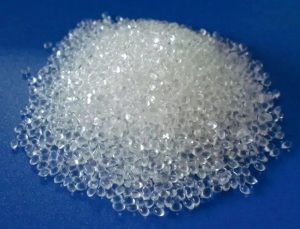Kunststoffterminologie – englische Abkürzung UND vollständiger englischer Name

Kunststoffterminologie – englische Abkürzung UND vollständiger englischer Name
| Abkürzung | Name |
| AAS | Acrylnitril-Bcryat-Styrol-Opolymer |
| ABS | Acrylnitril-Butadien-Styrol |
| ALK | Alkydharz |
| AMMA | Acrylnitril-Methylmethacrylat-Copolymer |
| AMS | Alpha-Methylstyrol |
| AS | Acrylnitril-Styrol-Copolymer (siehe SAN) |
| ASA | Acrylnitril-Styrol-Acrylat-Copolymer (AAS) |
| BMC | Massive Formmasse |
| CA | Celluloseacetat |
| CAB | Celluloseacetatbutyrat |
| PLZ | Celluloseacetatpropionat |
| CF | Casein-Formaldehyd-Harz |
| CFE | Polychlortrifluorethylen (siehe PCTFE) |
| CM | Chloriertes Polyethylen (siehe CPE) |
| CMC | Carboxymethylcellulose |
| CN | Cellulosenitrat |
| COPE | Polyetherester-Elastomer |
| CP | Cellulosepropionat (CAP) |
| CPE | Chloriertes Polyethylen (PE-C) |
| CPVC | Chloriertes Polyvinylchlorid (PVC-C) |
| CS | Casein-Kunststoffe |
| CSM &cspr | Chlorsulfoniertes Polyethylen |
| CTA | Cellulosetriacetat |
| DMC | Teigform-Tompound |
| E / P. | Ethylen-Propylen-Copolymer |
| CA-MPR | Schmelzverarbeitbarer Gummi aus Elastomerlegierungen |
| EA-TPV | Elastomer-Legierung thermoplastischem vulkanisieren |
| EC | Ethylen-Zellulose |
| EWR | Ethylen-Ethylacrylat-Copolymer |
| EP | Epoxid oder Epoxid (ausgehärtet) |
| EPDM | Ethylen-Propylen-Dien-Terpolymer |
| EPS | Expandierbares Polystyrol |
| ETFE | Ethylen/Tetrafluorethylen |
| EVA | Ethylen-Vinylacetat-Copolymer |
| EVAL/EVOH | Ethylen-Vinylalkohol-Copolymer |
| FEP | Fluoriertes Ethylenpropylen (TFE-HEP) |
| CPMC | Granulatformmasse aus Polyester |
| HDPE | Polyethylen hoher Dichte (PE-HD) |
| HIPS | Schlagfestes Polystyrol (TPS oder IPS) |
| HMWPE | Polyethylen mit hohem Molekulargewicht |
| LCP | Flüssigkristallpolymer |
| LDPE | Polyethylen niedriger Dichte (PE-LD) |
| LLDPE | Lineares Polyethylen niedriger Dichte |
| MBS | Methylmethacrylat-Butadien-Styrol-Copolymer |
| MC | Methylzellulose |
| MDPE | Polyethylen mittlerer Dichte (PE MD) |
| MF | Melamin-Formaldehyd |
| MPF | Melamin-Phenol-Formaldehyd-Harz |
| NC | Nitrozellulose |
| PA | Polyamid oder Nylon |
| PA6 | Polyamid 6 oder Nylon 6 |
| PA11 | Polyamid 11 oder Nylon 11 |
| PA12 | Polyamid 12 oder Nylon 12 |
| PA46 | Polyamid 46 oder Nylon 46 |
| PA66 | Polyamid 66 oder Nylon 66 |
| PA610 | Polyamid 610 oder Nylon 610 |
| PAA | Polyacrylsäure |
| PAA6 | Polyarylamid oder Poly-m-xylol-adipamid (PA MXD6) |
| PAN | Polyacrylnitril |
| PB | Polybuten-1 |
| PBI | Polybenzimidazol |
| PBT | Polybutylenterephthalat |
| PC | Polycarbonat |
| PCTFE | Polychlortrifluorethylen |
| PDAP | Polydiallylphthalat |
| PE | Polyethylen |
| PEBA | Polyetherblockamid |
| PEC | Chloriertes Polyethylen (siehe CPE) |
| PEEK | Polyetheretherketon |
| SCHÄLEN | Polyetherester (YPBO) |
| PEI | Polyetherimid |
| PEK | Polyetherketon |
| PEKK | Polyethylenketonketon |
| PEOX | Polyethylen(oxlde) |
| PES | Polyethersulfon |
| PET | Polyethylenterephthalat |
| PET-Erweiterung | (siehe PET) |
| PF | Phenol-Formaldehyd-Harz |
| PI | Polyimid |
| PMC | Polyester-Formmasse |
| PMCA | Polymethyl-α-chloracrylat |
| KMU | Polymethacrylimid |
| PMMA | Polymethylmethacrylat (Acryl) |
| PMMA-T | Gehärtetes Acryl |
| PO | Polyolefin |
| POM | Polyoxymethylen oder Acetal oder Polyformaldehyd |
| POM-CO | Acetal-Copolymer |
| POM-H | Acetal-Homopolymer |
| PP | Polypropylen |
| PPC | Chloriertes Polypropylen |
| PSA | Polyphenylenether (ss PPO) |
| PPO | Polyphenylenoxid – üblicherweise modifiziert |
| PPOX | Polypropylenoxid |
| PPS | Polyphenylensulfid |
| PPSU | Polyethylensulfon |
| PPVC | Weichgemachtes Polyvinylchlorid (PVC-P) |
| PS | Polystyrol (GPPS) |
| PSU | Polysulfon |
| PTFE | Polytetyafluorethylen |
| PU | Hartes Polyurethan-Elastomer |
| PUR | Polyurethan |
| PVAC | Polyvinylacetat |
| PVAL | Polyvinylalkohol |
| PVB | Polyvinylbutyral |
| PVC | Polyvinylchlorid |
| PVCC | Chloriertes Polyvinylchlorid |
| PVDC | Polyvinylidenchlorid |
| PVDF | Polyvinylidenfluorid |
| PVF | Polyvinylfluorid |
| PVFM | Polyvinylformal |
| PVK | Polyvinylcarbazol |
| PVP | Polyvinylpyrrolidon |
| SAN | Styrol-Acrylnitril-Copolymer |
| SBS | Styrol-Butadien-Styrol-Blockcopolymer |
| SEBS | Styrol-Butadien-Styrol-Blockcopolymer (gesättigt) |
| SI | Silikon |
| SMA | Styrol-Maleinsäureanhydrid-Copolymer |
| SMC | Sheet-Formmasse |
| SMS | Styrol-Methylstyrol-Copolymer |
| TP-EE | Thermoplastisches Elastomer – entweder Ester |
| TP-EPDM | Thermoplastisches Elastomer auf Basis von EPDM |
| TP-EVA | Mit thermoplastischem Elastomer umhüllt von EVA |
| TP-NBR | Thermoplastisches Elastomer auf NBR-Basis |
| TPE | Thermoplastischer Elastomer-Gummi |
| TPO | Thermoplastisches Polyolefin |
| TPO-XL | Thermoplastisches Polyolefin kautschukvernetzt (Gummi) |
| TPR | Thermoplastischer Kautschuk (Etaslomer) |
| TPU | Thermoplastisches Polyurethan |
| TPV | Thermoplastisches Elastomer oder kautschukvernetzt (Gummi) |
| UF | Harnstoff-Formaldehyd |
| UHMWPE | Polyethylen mit ultrahohem Molekulargewicht |
| UP | Ungesättigtes Polyesterharz |
| PVC | Weichmacherfreies Polychlorid |
| VC / E. | Vinylchlorid-Ethylen-Copolymer |
| VC/E/MA | Vinylchlorid-Ethylen-Maleinsäure-Copolymer |
| VC/E/VAC | Vinylchlorid-Maleinsäure-Copolymer |
| VC/MA | |
| | |
| VC/OA | Vinylchlorid-Octylacrylat-Copolymer |
| VC/P | Vinylchlorid-Propylen-Copolymer |
| VC/VAC | Vinylchlorid-Vinylacetat-Copolymer |
| VC/VDC | Vinylchlorid-Vinylidenchlorid-Copolymer |
| VE | Vinylesterharz |
| VLDPE | Polyethylen sehr niedriger Dichte |
Plastische Terminologie
